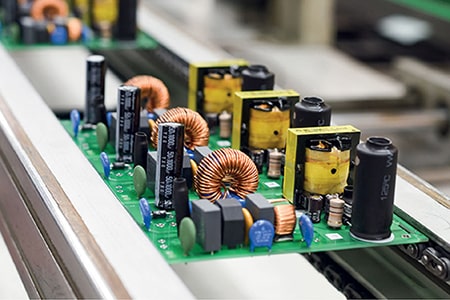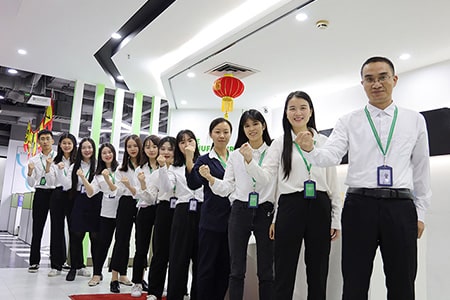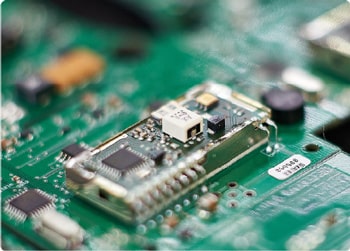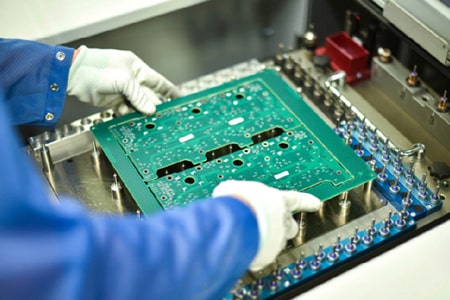Metal Core PCB (Metal Core PCB)
The Heat Dissipation-Critical Board ChoiceWith the increasing popularity of LED lighting, automotive electronics, and high-power power supplies, the heat dissipation and reliability bottlenecks of traditional FR-4 are becoming increasingly apparent. Metal Core PCB (MCPCB), also known as aluminum or copper PCB, has become a mainstream choice for thermal management due to its excellent thermal conductivity and structural strength.
Metal Core PCB
A metal core PCB is a board system that consists of a metal substrate (commonly aluminum or copper) coated with a highly thermally conductive insulating dielectric, then covered with copper foil and fabricated using conventional PCB patterns. Its core value lies in quickly transferring heat generated by the device from the copper foil to the metal substrate and dissipating it over a larger area, thereby reducing junction temperature and improving reliability and lifespan.
MCPCBs typically consist of three layers: a conductive layer, a thermally insulating layer, and a metal substrate layer. This structure enables effective thermal management, ensuring the reliability and lifespan of electronic devices, especially in high-power applications such as LED lighting and power electronics.
Metal-Based PCB Types
1. Classification by Metal Base Material
Aluminum Core
Advantages: Cost-effective, lightweight, and widely used (LEDs, power supplies)
Copper Core
Advantages: Improved thermal conductivity and heat dissipation, and better thermal stability; Disadvantages: High cost and heavy weight
Suitable for: High power density and severe thermal shock (automotive lighting, PA, power conversion)
Steel/Stainless Steel/Mild Carbon Steel
Advantages: High mechanical strength and manageable cost; Disadvantages: Poor thermal conductivity
Used for: Moderate heat dissipation requirements but requiring structural strength
Composite Metal Core (a limited number of high-end applications)
High cost, mostly found in high-reliability power modules or package-level heat sinks
2. Classification by Circuit Structure and Layer Count

Single-Sided MCPCB (Most Popular)
Structure: Copper foil/thermal insulation layer/metal substrate
Low cost, high reliability, suitable for LEDs, adapters, power supply primary side, etc.
Double-sided MCPCB (with insulated vias)
Interconnects upper and lower layers through insulated vias, resulting in complex processes and higher costs.
Suitable for boards requiring both signal routing and heat dissipation.
Multi-layer MCPCBMulti-layer circuitry and metal core composite laminate (metal can be embedded in the center or back). Due to high yield and cost pressures, it is typically only used in high-end power supply/automotive applications.
Metal-backed PCB PCBMulti-layer FR-4 stackup with thermally conductive adhesive and metal plate applied to the backside is considered "back metal" rather than "metal core." This is a compromise between traditional multi-layer and MCPCB.
Metal Core PCB Manufacturing Process
1. Metal Core PCB (MCPCB) manufacturing typically begins with selecting an aluminum or copper substrate and a thermally conductive dielectric (thickness/thermal conductivity).
2. Lamination is performed to form an IMS copper-clad laminate.
3. Dry film lamination, exposure, development, and etching are performed to form the circuit.
4. Drilling is performed (if double-sided interconnection is required, insulated vias are made and then plated).
5. Solder mask and marking are applied, and surface treatment (ENIG, OSP, lead-free HASL, etc.) is performed.
6. CNC contouring and countersinking/tapping are performed.
7. After cleaning and deburring, electrical testing and withstand voltage (Hi-Pot) are performed.
8. Appearance and dimensional inspection are performed, followed by packaging and shipment.
Critical control points include dielectric thickness and withstand voltage, flatness and warpage, hole wall insulation reliability, and matching the reflow soldering thermal profile with the thermal capacity of the large metal substrate.
Why Choose Metal-Based PCBs?
Efficient Heat Dissipation: The insulating dielectric has a high thermal conductivity (typically 1–3 W/m·K, with a maximum of 5–8). Heat is quickly transferred to the metal baseplate, significantly reducing device junction temperature (10–30°C for LEDs, etc.).
Improved Reliability: Lower temperatures, reduced thermal cycling stress, less fatigue in solder joints/dielectrics, slower LED light decay, and longer capacitor life.
Higher Power Density: Carrying more power within the same space, reducing the size of thermal vias and heat sinks, and even enabling fanless designs.
Excellent Structural Strength and Flatness: Metal baseplates are resistant to warping and vibration, making them suitable for assembling large or heavy components and automotive/industrial applications.
EMI and Grounding Optimization: Large metal surfaces can serve as shielding/ground reference planes, reducing noise and loop impedance (insulation must be insulated according to specifications).
Dimensional and Thermal Stability: Metal provides more uniform heat diffusion, minimizes temperature gradients, and provides more controllable CTE, reducing the risk of thermal mismatch between components and the baseplate.
System-Level Cost Reduction: Although the price per board is higher, it reduces the need for independent heat sinks, thermal grease/gaskets, fans, and assembly steps, resulting in a more cost-effective overall system.
Process/Function Integration: Capable of countersunk holes, tapping, heat sink fins, and direct heat paths (DTP/copper inserts), further reducing thermal resistance.
Typical Application Scenarios
LED Lighting: COB/COG light sources, street lights, mining lights, and automotive lights, UV/IR LED curing, and medical applications.
Automotive Electronics: Headlight modules, power drivers, onboard chargers, DC/DC converters, and inverters.
Industrial Power Supplies and Motor Drives: MOSFET/IGBT power boards, rectification, and PFC.
Communications and RF: Power amplifiers and RF modules (necessary to consider dielectric parameters and heat dissipation).







